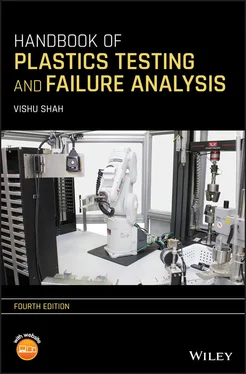The illustrations described above are primarily for mechanical properties, but the increase in testing technology has occurred in almost all other aspects of material testing, including thermal and analytical analysis. Examples include the measurement of the coefficient of thermal expansion and Fourier transform IR analysis (FTIR).
The coefficient of linear thermal expansion (CLTE), which measures the change in length of a specimen with a change in temperature, was previously measured with analog dilatometers and temperature baths that limited the measurement range from –30 °C to 30 °C, according to ASTM D696. With the advent of composites and high‐temperature polymers, the current use temperature can often vary from –40 °C to 250 °C. Today’s technology employs a Thermo Mechanical analyzer (TMA). The TMA is controlled by a computer and the temperature versus expansion is precisely monitored over a much broader temperature range. ASTM D696 has been revised to reference ASTM E228 for higher temperatures, reflecting the increased temperature control required to measure CLTE at elevated conditions.
Fourier transform IR analysis, which measures a materials absorption and transmission of infrared light, has been an advancement primarily in the way the spectra, which act as a materials fingerprint, are compared. In the past, the analytical chemist would utilize books of known references and compare scans of the material being analyzed to the references for identifications, often a very time‐consuming task. Today, with computerized data acquisition and libraries consisting of thousands of references, the computer performs the peak matching, which makes identification less time‐consuming, more consistent, and provides complex spectra subtractions for the identification of contaminants.
In addition to technological advances, the testing industry has witnessed a major increase in the acceptance and use of globally recognized testing standards with a new emphasis on characterizations performed by ISO and IEC (International Electrochemical Committee) test methods. These procedures are truly internationally agreed upon methods adopted under a one nation one vote system and provide the common testing language appropriate to an industry dominated by global markets. CAMPUS (Computer‐Aided Materials Pre‐selection by Uniform Standards), which uses ISO and IEC data, provides material properties in a standardized format so that engineers, designers, and plastics purchasers can now choose materials in an “apples to apples” comparison as never before.
The technical advances referred to in the preceding paragraphs are just a few examples of the many changes that have occurred in polymer testing in the past two decades. To keep abreast of changes that occur, the polymer testing professional must continually update his/her knowledge of the industry, the information required by the industry, and the technology available to provide data that is both meaningful and accurate. Handbooks, such as the Fourth Edition of The Handbook of Plastics Testing Technology , provide a way to keep up with changes that are occurring. Also, participation in standards organizations, such as ASTM and ISO, provide first‐hand knowledge of changes that are taking place in the industry, as well as revisions that are being made to test methods. As applications for polymers become more and more advanced, the information that is generated by the polymer testing laboratory will have to keep pace through technological improvement.
1.6. NEW DEVELOPMENTS AND TRENDS IN TESTING TECHNOLOGY
Automation, speed, and instrumentation are the key new developments in testing technology since the new millennium. An increasing number of test equipment manufacturers are engaging in developing instruments that require less human intervention and operate at faster speeds. Automation is accomplished by the use of robotics. This type of automated system has been proven to be cost‐effective for performing tensile, flexure, and impact tests on large quantities of samples, while freeing up personnel for more demanding tasks. In combination with a six‐axis industrial robot and a bar code scanner, a system can be configured to feed multiple testing machines with a single robot. A system developed by a leading manufacturer (6) uses state‐of‐the‐art web technologies (webcam, e‐mail, SMS), ensuring a constant process control and remote diagnostic of the system. The data generated by the instrument are analyzed and seamlessly integrated with other office automation programs. Figure 1‐1shows one such highly automated test setup. Automation has also led to highly accurate and reproducible specimen preparations. A microprocessor‐controlled notching instrument for impact tests can notch up to 50 specimens all in one operation. The notcher uses a linear cutting motion that reduces friction and induced stresses generated by traditional rotary notchers. Figure 1‐2shows an automated notcher.
More and more companies demand a fast turnaround of test results. Equipment manufacturers have met this challenge by developing faster instruments, such as a twin‐bore capillary rheometer, as shown in Figure 1‐3. Twin barrels allow the Bagley correction in one run and they also double the output effectively combining two rheometers into one unit. This means that testing time is considerably reduced; more pressure–velocity increments can be applied to one change of material and the test can run automatically while the operator performs other tasks. The use of the Internet to deliver data to customers is increasing. The customer receives the data within minutes after the tests are completed. Such web‐based material data management systems (7) have the ability to securely store, display, and output diverse material properties for a variety of materials in complex formats, including CAE material model parameters. Material suppliers now have the ability to store and publish or selectively distribute their data instantly across the globe.
The use of instrumented testing to study the impact properties of plastic materials is also on the rise, and industry has witnessed a significant expansion in the application of instrumented testing. Instrumented testers are capable of generating and providing much more meaningful data as compared to conventional instruments. Instrumented instruments are better suited for research and development, as well as simulating real‐life conditions. Whereas the non‐instrumented tests generally measure the energy necessary to break the specimen, instrumented impact tests provide curves of high‐speed stress–strain data that distinguish ductile from brittle failure and crack‐initiation from crack‐propagation energy. The latter gives a more nuanced picture of the “toughness” of a specimen (8). With instrumented impact, the falling dart’s tip or the pendulum’s hammer is fitted with a load cell. The force–time data during the actual impact are stored by a high‐speed data‐acquisition system. These data can be used to generate curves showing force, energy, velocity, and deformation versus time. By analyzing these curves, one can learn (a) the force, energy, and deformation necessary to initiate a crack and then to cause total failure, (b) the rate sensitivity of a material to impact loading, and (c) the temperature of a material’s transition from ductile to brittle failure mode. The advent of piezoelectric sensors for instrumented impact testers is said to provide greatly increased sensitivity, allowing for testing of very light films, foams, and most other materials used in packaging. Developments in fracture mechanics analysis applied to polymers have now been incorporated into ISO 17281, so it is now possible to study the intrinsic impact properties of plastic materials. Two properties, the critical stress intensity factor (K1C) and the energy release rate (G1C), can be isolated as inherent fracture characteristics independent of the actual geometry and dimensions of the finished product; as such, they can be utilized in CAD tools to determine fracture performance. One such instrumented impact tester is shown in Figure 1‐4.
Читать дальше











